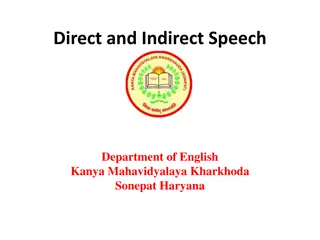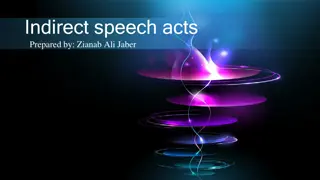Indirect Rate Strategies
Learn from experts Donna Dominguez and Tram Vo on developing competitive budgeted indirect rates and structuring for success in government contracting. Discover the importance of indirect rate structures and ways to optimize your pricing strategies. Join the webinar to enhance your financial compliance knowledge and grow your business effectively.
Download Presentation

Please find below an Image/Link to download the presentation.
The content on the website is provided AS IS for your information and personal use only. It may not be sold, licensed, or shared on other websites without obtaining consent from the author.If you encounter any issues during the download, it is possible that the publisher has removed the file from their server.
You are allowed to download the files provided on this website for personal or commercial use, subject to the condition that they are used lawfully. All files are the property of their respective owners.
The content on the website is provided AS IS for your information and personal use only. It may not be sold, licensed, or shared on other websites without obtaining consent from the author.
E N D
Presentation Transcript
Indirect Rate Strategies: How To Budget for Success! October 17, 2023
Todays presenter Donna Dominguez Donna Dominguez Government Contract Compliance Leader & Advisory Partner, Aprio Donna has more than 20 years of experience providing a wide range of financial compliance advisory services to government contractors. She is experienced in matters related to FAR, CAS, ICS, DCAA cognizant audit support, provisional billing rates, establishing or revising indirect rate structures, and cost proposal support. Donna works with government contractors to help them grow their businesses while keeping their accounting systems adequate and their billing systems current and relevant. She is also involved in supporting the government contracting community as a frequent guest speaker and author on a variety of compliance topics. LinkedIn
Todays presenter Tram Vo Tram Vo Senior Manager, Government Contracting, Aprio Tram Vo is a Senior Manager in Aprio LLP s Government Contracting Services Group with 15+ years of experience and knowledge of Federal Acquisition Regulations (FAR). Tram began her career with the Defense Contract Audit Agency (DCAA) working with contractors on Incurred Cost Submission audits, Forward Pricing Proposals, Defective Pricing, Cost Accounting Standard Review, Floor checks and more. She also has experience with both small and large contractors and understands the critical compliance issues and needs for each. She has extensive experience with monthly accounting & billings, provisional bill rates, adequate accounting systems, estimating systems and contract administration. LinkedIn
How to Earn CPE Credits We are using Zoom as the learning webinar platform. To earn full CPE credit for this course, you must answer at least three out of the four of the polling questions. You will receive credit if you answer the polls, not whether you get them correct.
Learning Objectives Participants will Recall how to develop competitive budgeted indirect rates and structure
Discussion Agenda Top 5 Reasons for Budgeted Indirect Rates Pricing Strategies How to Budget Q&A
Who should prepare budgeted rates and evaluate their rate structures? All Government Contractors whether required by contract or not. Why do I need to prepare my budgeted rates? In order to establish your provisional billing rates for invoicing and for cost build up on cost proposals. Why do I care about my indirect rate structure? So that you can ensure your business is staying competitive in the market. The 5 W s of Budget Rates & What is the purpose of establishing provisional billing rates? It allows you to invoice on flexibly priced contracts at budget rates before you true up to actuals. It also helps to measure performance and profitability on Fixed Price (FP) and Fixed Labor Hour (FLH) contracts. Rate Structures When do I need to prepare my budget and evaluate my rate structure? At a minimum once a year for both. Wheredo I submit my provisional rates? It depends whether it s for yourself, the contracting officer, or the cognizant Federal agency official. For those that have Disclosure Statements (D/S), if you revise your rate structure, you will have to submit your revised D/S to DCMA.
Top 5 Reasons for Budgeted Indirect Rates PRIVATE & CONFIDENTIAL
CPE Question 1 Have you ever submitted budgeted rates for compliance with your contracts? Yes No
Top Reasons Why You would Prepare an Indirect Rate Budget Contractual requirements (FAR 52.216-7(e) Allowable Cost & Payment Clause & Subpart 42.7) Evaluating your business for future goals and strategies To be compliant with your estimating system To budget/adjust costs for growth, acquisitions or loss Using budget rates for proposals and invoicing
% Budgeting Indirect Rate (while trying to stay competitive!) Finding the right balance between existing work with future contracts, all while still being competitive and profitable is a difficult balancing act.
Indirect Rate Strategies How do you know what is the right rate structure for you? How many Overheads should I have? What is a reasonable G&A rate? Is it a good time to restructure after acquisition? When do I need an SM&H Rate?
Indirect Rate Strategies Two Key Things to Remember 1 2 When one rate goes down, another will go up. Your cost are your costs.
Things to Consider When Preparing your Budget Rates Understand your business What products/services do you offer? How are you different from competitors? What are customers telling you? What does your win/loss history reveal? What is your contract and customer mix? How do labor limit and costs set by Prime Contractors factor into your cost structure?
CPE Question 2 What is the current contract mix at your company? Select all that apply. Majority Cost Type Majority T&M Majority Fixed Price
Steps to Begin the Budgeting and Rate Structure Process: Once you have your historical costs and a baseline understanding of the company s strategic goals and target wrap rate, begin building your budgeted rates. Review costs in each pool, service centers, allocation basis, and new items. Are the costs on a causal / beneficial relationship? Do I have different lines of business or locations that require difference in cost? Have we had any acquisitions that I now need to consider into our overall rate structure?
Steps to Begin the Budgeting and Rate Structure Process: Begin preparing different rate structures until you get to the one that is closest to your goals. Review the impact to your existing contract mix. How does this effect our profitability on FP and T&M contracts? Review internally and submit to ACO/CO & DCAA or Cognizant Audit Agency. Implement new provisional billing rates into your system and begin billing.
Pricing Strategies Discounts, Impacted Rates & TCI vs. Value Add G&A Base PRIVATE & CONFIDENTIAL
What is it? When Should I provide a Discount? When your budgeted G&A Rate is high and not competitive on a particular proposal, you can offer a one time self imposed capped/discounted G&A Rate o It can be limited to Subcontractors/Consultants or Materials or Travel Costs only. For bidding and pricing strategy would be to discount the G&A on the subs when you have a TCI (Total Cost Input) G&A base o This means you are self imposing a ceiling on your G&A rate for that award when you bill your subcontractor costs o You can offer discounted G&A rate on any pass-through item or cost. You reduce your profits!
Discounted rate(s) Continued Offering discounts does not alleviate the costs allocated to the project. Discounts reduce the overall profitability of the contract. Calculate non-billable costs to make good business decisions.
CPE Question 3 Have you ever proposed discounted rates in a cost proposal? Yes No
Impacted G&A Begin with your original budgeted indirect rates and impact or update for this one effort/RFP. Since the original budget did not include such a large effort, we now need to impact the original budget to reflect the appropriate impacts on the business should you win this award. o This can be increased direct costs o This can be increased indirect costs o This could even include different indirect rates To not include would mean you are not considering all the costs that would impact your quote. o This often means you will have lower bidding rates!
Value Add G&A Base vs. Total Cost Input Value Add G&A Base is all direct costs before B&P, IR&D, Subcontractors, Consultants and Material costs. Total Cost Input G&A Base is all direct costs before B&P and IR&D. Subcontract & Material Handling (SM&H) Subcontract Handling (SH) Material Handling (MH)
Unpopulated Joint Venture (JV) G&A for the JV is derived from the G&A pool costs from some or all of the members of the JV. Joint Venture s G&A Rate has a different rate than your entity and likely G&A pool costs coming out of your entity for the JV. Typically, 2% to 4% for JVs (Common are mentor prot g ).
How to budget PRIVATE & CONFIDENTIAL
Tips for Rate Structures Think Service Centers How are you allocating your service center? For companies where people wear many hats (think Labor Hours), Second preference might be Labor Dollars. Costs must be allocated on a causal/beneficial relationship. o Commons SVCs (Facility or multiple Facility, IT/MIS, Contracts, etc.) o How do you handle working from home? o Does it have a material impact on the allocation? o Make a decision and be consistent.
Tips for Rate Structures Review your Indirect Cost Pools Look at what costs are going in the G&A Pool what can be reclassified? Business Development (BD) to G&A vs. Bid & Proposal (B&P) for Overhead and Direct Personnel. Payroll costs is this G&A or can this go in the Fringe Pool? Training and education is this all for G&A? Human Resources, can this be allocated to everyone like IT? Who is charging to G&A and is that correct? BD time for Overhead personnel where are you booking those costs?
Tips for Rate Structures Review your Indirect Cost Pools Performance based bonus dollars Follow the labor or in the fringe pool? You have a great system, LEVERAGE IT! Recruiting Costs Follow the labor. This will likely lead to most of the cost in the Overhead Pool(s). Be consistent when applying like costs. Office supplies and Facility Service Center (CAS 401)
Tips for Rate Structures Review your Indirect Rate Structure If you are not CAS Covered (have a Disclosure Statement): Take your budgeted costs and play What If scenarios in Excel. Upload that into your accounting system to measure and track your performance against budgeted costs. Monitor budgeted rates to actuals. Remember if you become materially different, you should try to adjust spending to get back on track but if that will not work, you should resubmit your revised budgeted indirect rates.Then adjust cumulative year to date costs billed to the new budgeted rates. Run Project Cost Ledgers on a monthly basis to monitor Actuals vs. Budgeted.
CPE Question 4 Do you currently monitor your budgeted rates to your actual rates? Yes No
Your CPE Certificate Upon successful completion of this course, your CPE certificate will be emailed to you within 10 business days. Note: You will receive credit if you answer at least three out of the four polling questions, whether you get them correct or not.
Course Evaluation Attendees, we want your feedback! The producer sent the link to the course evaluation in the chat. Please follow the link or scan the QR code here to take the survey now.
Thank you! Donna Dominguez Donna Dominguez Partner, Government Contract Services Group 301-222-8232 donna.dominguez@aprio.com Tram Vo Tram Vo Senior Manager, Government Contracting 240-364-2616 tram.vo@aprio.com























